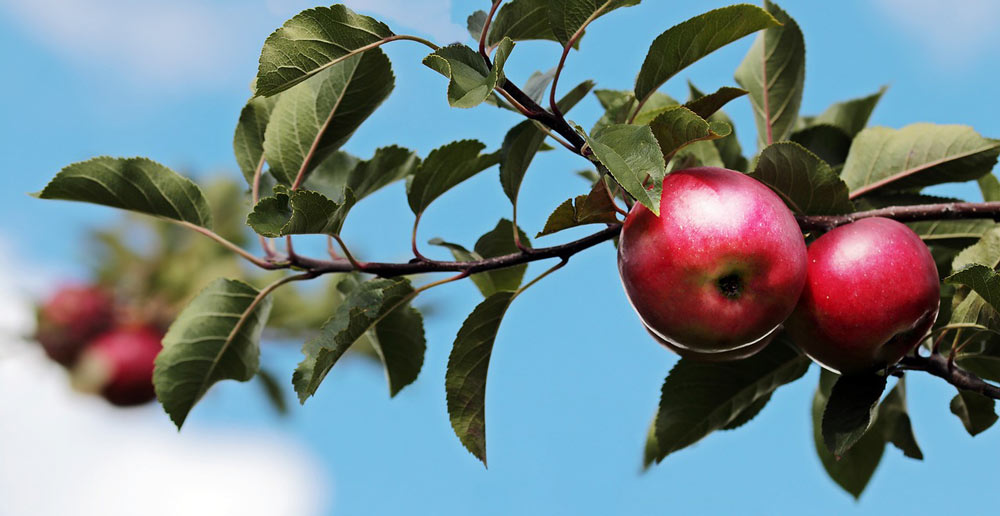Most people can easily tell apart apples from bananas, and oranges from blackberries. But, how easy is it to identify the plants they come from? To find out, here’s a guide on how to identify the 10 most common fruit plants.
Before we begin, let’s go over some basics of plant identification. The most important thing to look at is the leaf type. They can be simple or compound, meaning just having one leaf blade or multiple. Additionally, leaves can be arranged opposite of each other, or alternately along the stem. The most common type of leaf by far is simple and alternate.
Now, as for the fruit we’ll be discussing – how do you classify a common fruit? For the sake of this list, we refer to the top fruits sold in the US according to the Produce Marketing Association.
On with the identification! Here’s a list of the 10 most common fruit plants, and how to identify them.
Bananas
Bananas are the most sold fruit in the US. All bananas are grown far away from the US in the tropics, mostly in Central and South America. Banana plants themselves, even without the iconic yellow fruit, are very easy to identify. Often referred to as “trees”, banana plants are technically an herb. In fact, they are the world’s largest herb! They have thick stalks and a handful of huge, long leaves at the top.

Apples
Apples are a schoolteacher’s favorite, doctor repelling fruit. The trees they come from are a common ornament in yards, sometimes a relic from an orchard long-gone. Without its fruit, though, these trees can be hard to identify.
The leaves are always simple, arranged alternately on a branch. Additionally, the leaves are “serrated” or toothed on the edge. The flowers are white or pink and smell very sweet. Older apple trees will have flaky bark, that falls off in long strips.

Grapes
If you’ve ever been to a vineyard, you’ve seen grape plants. The small purple or green fruits grow on vines that can become rather unruly. When kept in check, grapevines will happily produce fruit year after year.
Depending on the variety of grape, the leaves will look slightly different. In general, the leaves of the vine are usually large and rough, with three to five lobes. The woody, thicker part of the vine has flaky bark like a cedar tree, while the thinner portions are smooth and coppery red. Look for these characteristics when you’re trying to identify this fruit plant.
Strawberries
Strawberries are a sure sign of summer in many parts of the world. The small fruit comes from a plant equally as small. The little herb grows usually no more than 20 centimeters (8 inches) from the ground. The leaves are compound, with no more than 3 leaflets all right next to each other.
Strawberry plants often produce “runners” which trail off in any direction and sprout up as new plants. The flowers and fruits hang just below the leaves.

Citrus
Oranges, lemons, and limes are all in the citrus family. Because the trees all look so similar, let’s just pretend they’re all the same fruit for now. In reality, different kinds of citrus fruits can be really tough to tell apart until they’re ripe.
Citrus trees tend to have dark green leaves and are usually covered in spines. So, have caution when you pick a lime off a tree, you could get poked! Aside from the spines and leaf color, the smell of a crushed up leaf is unmistakable. Nearly all plants in the citrus family, from lemon trees to wild herbs, have extremely fragrant oils that smell, well, citrusy!

Watermelon
Another icon of summer, the watermelon, is one of the heaviest fruits around. What kind of plant can support that kind of weight? It turns out, no kind can! The watermelon plant is a vine that runs along the ground, and the fruit itself grows laying right on top of the soil. Look for big, lobed, and wavy-edged leaves on the ground when trying to identify a watermelon plant.

Blueberries
Blueberries are closely related to cranberries and huckleberries. Without fruits, identifying the plant can be hard. They are always shrubs and can range from 10 centimeters to 4 meters tall. However, farmed blueberries will hover somewhere around a meter tall to make harvesting easier.
The leaves of a blueberry bush are small and pointed, and always arranged alternately on the stem. The shrubs themselves can be quite dense and are also fragile.

Pineapple
These spiky fruits are a tropical staple. It’s one of the most popular fruit in the tropics of the world, and almost as adored in temperate regions. Luckily for us, the pineapple plant is the most unique looking one on our list, making it a piece of pineapple upside-down cake to identify.
The plant itself is in a family of plants called bromeliads, which are characterized by having lots of long, tough leaves that grow in a “rosette” formation. In the wild, this form allows bromeliads to catch falling organic matter which they can use for extra nutrients. For us, it makes them a pretty easy fruit plant to identify!

Avocado
The fruit of Millenials, as it’s often referred to, is the avocado. Who can resist a fresh slice of avocado toast? The avocado tree is another fruit plant notoriously hard to identify without the tasty part. The leaves are simple and alternate, and shiny green. When crushed up, they emit a sort of spicy smell, similar to anise, which is unrelated. The smaller stems of an avocado tree are light green, turning brown as they get older.

Raspberries and Blackberries
These two berries, along with boysenberries, marionberries, and loganberries, are what we call brambles. They grow as vines that like to climb and cover everything in their path. If you’ve ever been to a farm picking these fruit, you probably know how densely covered they are in tough, sharp spines. Botanically speaking, these popular fruits aren’t even berries. Rather, they’re aggregate fruit, but I digress.
Bramble leaves are always compound, with 3 to 5 leaflets. The flowers are almost always white and actually, look very similar to apple flowers. After all, they’re both in the same botanic family, Rosaceae.
So there you have it! Identifying common fruit plants is made easier by looking closely at their leaves. If you can find the correct leaf, then you should be able to identify the source of your favorite fruit next time you cross it.













































